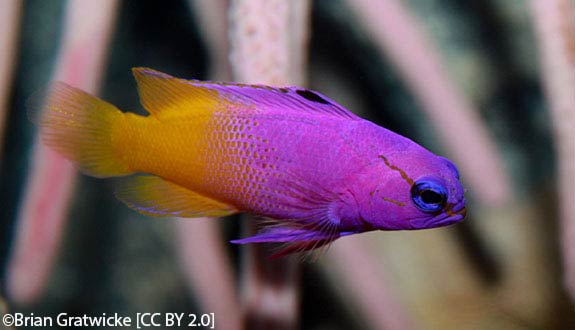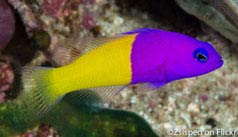

Alternative species (click on the thumbnail to see the card)
Names
Scientific name
Gramma loreto
Common name
Royal gramma
Fairy basslet
Royal Gramma Basslet
Origin

Origin: Bermuda (Caribbean)
Natural habitat: it lives in coral reefs, up to 40 metres / 130 feet deep.
Dimorphism

Hard to see. The female is slightly smaller than the male.
Group

Grammatidae
Volume

200 L / 44 Imp Gal / 53 US Gal
Parameters

T°: 24 to 26°C or 75 to 79°F
pH: 7.5 to 8.5
Density: 1021 to 1026
Difficulty

Easy
Size

8cm (3.1")
Longevity

3 to 8 years
Living zone

Depth
Individuals

1
Food
How to feed the Royal gramma?
Food
How to feed the Royal gramma?
The Gramma is carnivorous. Its diet consists in captivity of small live prey: red daphnia (very good to enhance its beautiful colours!), artemia, mysis, small krill, pieces of shrimp or mussels...
After cheering, it also accepts frozen and dry food.
Behavior
What kind of behavior does the Royal gramma have?
Behavior
What kind of behavior does the Royal gramma have?
In nature, we meet groups of several dozen individuals. It is therefore generally quite sociable and enjoys the company of its fellow creatures. However, it can show a certain aggressiveness towards its fellow creatures if the aquarium is too small. Thus, you can only consider the maintenance of several individuals in tanks of at least 500 liters / 110 Imp Gal / 132 US Gal, at a rate of one Gramma every 200 liters / 44 Imp Gal / 53 US Gal. Its aggressive behaviour is very visible: mouth wide open and intimidating posture.
Within the group, a hierarchy is established, and the biggest fish is usually the dominant one.
It is very active during the day and swims continuously along the scenery, especially in the lower part of the aquarium. Sometimes you will see him swimming with his belly up! At night, this fish rests in a hole formed by the stones of the decor.
At the slightest danger, this fearful fish will run into its hole and come out a few moments later. If it is uncomfortable in its aquarium or if roommates intimidate it, it spends its time hiding, which is not normal (check that no other fish is bothering it).
Occasionally, he may de-pest his roommates.
Cohabitation
Who can live with the Royal gramma?
Cohabitation
Who can live with the Royal gramma?
Even if this small fish has a rather pronounced character towards its congeners, it seems reserved and shy in front of other fishes. Therefore, avoid associating it with fish that are too big, too stirring or too virulent, which could intimidate it.
Do not associate it with other fish in the close livery such as Pseudochromis paccagnellae (vanilla-strawberry) because these species are very aggressive towards each other.
Breeding
How to breed the Royal gramma?
Breeding
How to breed the Royal gramma?
Reproduction is quite difficult. You will be able to obtain viable spawning and oviposition, but the maintenance of the fry in aquariums is still delicate today, and will require professional installations.
The fish are sexually mature when they reach the size of 3/4 cm. The couple will lay their eggs in a hole that they will create by lining the walls with algae (caulerpes for example). After laying the eggs, the male will continue to clean and monitor his cave for the duration of the incubation period (10 to 11 days).
At birth, the fry measure approximately 3/4 mm. In most cases, in captivity, they die during the first few days.
Its aquarium
Which aquarium for the Royal gramma?
Its aquarium
Which aquarium for the Royal gramma?
A reef aquarium made of rocks and invertebrates (corals) will suit it very well. It never damages the corals. The presence of some algae such as caulerpes is also appreciated by the species.
In the wild, it always lives close to scree or rock falls. Recreate these conditions by arranging your rock scenery vertically and forming caves and holes. If you have more than one Gramma, think carefully about the arrangement of your rocks so that each individual faces its own territory and is satisfied with it.
Good To know
Find all additional information!
Good To know
Find all additional information!
Tip: to be sure to have a couple, buy a small group (be careful with the volume of your aquarium!) in which you will choose a big fish and some smaller ones. The biggest one will certainly be a male, and in the smaller ones you have a good chance to have a female!
Very sturdy and easy to maintain, this species is perfectly suitable for beginner aquarists.
It looks a lot like its cousins Gramma brasiliensis and Pictichromis paccagnellae (they are not of the same family). Pictichromis paccagnellae has a very clear delimitation of its colours, unlike the Grammas, whose pink shades change to yellow. The Gramma loreto has a dark line under the eye that Gramma brasiliensis does not have.
Gramma loreto difference

It can also be confused with Lipogramma klayi, the two-coloured dwarf serran. However, the latter does not have a black dot on its dorsal fin or the dark line that runs through the eye of the Gramma Loreto.
Because breeding is quite difficult, most specimens sold commercially come from wild collection.
Its name "Loreto" comes from Spanish and means "little parrot", in reference to its magnificent coloration!
Yours photos!
Comments
Sort by:
Please login to post comments


